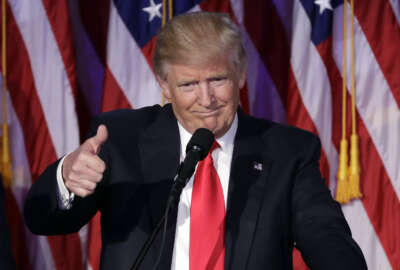

For all the rancor of the 2016 presidential campaign, officials working behind the scenes in the presidential transition say the outgoing Obama administration will...
For all the rancor of the 2016 presidential campaign, officials working behind the scenes in the presidential transition say the outgoing Obama administration will do everything in its power to ensure a seamless handover to President-elect Donald Trump.
Members of President Obama’s transition team and veterans of previous transitions said Nov. 10 that the President felt a debt of gratitude to his successor — long before Election Day — after the thorough cooperation of President George W. Bush’s transition team in 2008.
Andrew Mayock, co-chair of the Agency Transition Directors Council and a senior adviser to the director of the Office of Management and Budget, said White House Chief of Staff Dennis McDonough signaled the need for transition planning as early as December 2015.
“One of my first phone calls was from the Chief of Staff’s office, saying ‘Congratulations, you’re playing a key role in the transition and we need to get started. The President wants us to be on top of this, the President wants this to go well. He appreciated the hand off that he received eight years ago, and we’re starting earlier,'” Mayock, said during a transition panel at the National Academy of Public Administration on Thursday.
Chris Lu, the deputy secretary at the Labor Department and the executive director of the Obama-Biden Transition Project, said for all the barbs that have been traded between Obama and Trump this campaign season, the handover of executive power requires a drastic change of tone.
“Obviously we’re moving to governing now, we’re doing this in a nonpartisan, bipartisan way, but it’s fair to say that there are a lot of raw feelings, raw emotions that, I think, it’s going to take a while for folks to get over. But the President set the right tone in his remarks yesterday — both he and the first lady extending the olive branch, and that certainly sets the tone for how we deal with transitions throughout the rest of the government,” Lu said.
The Trump administration will be responsible for hiring nearly 4,000 political appointees and assembling a Cabinet before Inauguration Day on Jan. 20, 2017. Lisa Brown, who served as the co-director of agency review for the Obama-Biden transition team, said shaping the next administration requires a much different skillset than campaigning.
“Running a transition is a major management function, and so going from a campaign that has really been about message and ideas, in a transition you actually start to have to think about how am I going to implement those ideas,” Brown said. “For the incoming team, you’re now not representing your party, you’re representing your country. There’s certainly a professionalism that comes over when you move into transition … You’re going to be moving into the White House, you’re going to be moving into federal agencies. You have to act appropriately.”
As the second-in-command at Labor, Lu outlined the lessons learned while crafting the agency’s “briefing book,” which will inform Trump’s political appointees with the nut-and-bolts of how to keep it operating. Clocking in at around 800 pages, the Labor Department’s briefing book outlines the state of its IT, innovation, human resources and proposal for a new office building.
Lu said this version of the briefing book aims to cut down on some of the fluff that’s padded earlier versions of the document.
“Our overall transition book in 2008 literally started with ‘The Department of Labor was founded in 1913,’ and gave a historical timeline over the last 100 years,” Lu said, joking that it probably even included a biography of the first woman labor secretary, Frances Perkins.
This time around, Labor’s briefing book for the Trump administration will take a more pragmatic and instructional approach.
“Basically, if you could find it on the Department of Labor website, we weren’t going to duplicate it. We assume that they had done their homework. And it was really focused on what are the key things that the new leadership needs to know in the first 30, 60, 90 days. And we sort of assume that after that, you kind of know what you’re doing, or you’ll figure it out along the way,” Lu said.
Read the latest news about the incoming administration on our Tracking the Transition page.
Copyright © 2025 Federal News Network. All rights reserved. This website is not intended for users located within the European Economic Area.
Jory Heckman is a reporter at Federal News Network covering U.S. Postal Service, IRS, big data and technology issues.
Follow @jheckmanWFED

